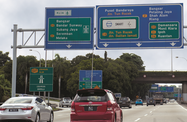With work set to begin on Kuala Lumpur’s Mass Rapid Transit (MRT) network this summer, its supporters hope that the 150-km rail system will ease transportation congestion in the capital and boost economic growth. However, some sceptics are doubtful that the project can deliver on all of its promises and think the money would be better spent on improving the existing system.
The Malaysian capital has long suffered from traffic problems, in part due to increasing rates of car ownership and a public transport network that has been criticised for not providing a sufficiently integrated service. According to government estimates, public transport usage in the great metropolitan area was 18% in 2009.
The state hopes that the RM36bn ($11.8bn) MRT will help alleviate congestion, by offering a fast, efficient and comfortable public transit option. The new network will comprise two radial lines running from the north-east to the south-west and linking high-density work areas with residential suburbs, as well as one circle line around the city.
Preliminary construction on the first line is scheduled to begin in July, with service due to open in 2016. Once completed, this 60-km, 35-station line will run from Sungai Buloh to Kajang via the city centre. The full MRT network, projected to be ready by the end of the decade, is expected to carry around 2m passengers a day.
The government has high hopes for what will be the largest infrastructure project in Malaysia. In late December, Prime Minister Najib Razak announced that the MRT would contribute between RM3bn ($1bn) and RM4bn ($1.3bn) a year to the economy through 2020, thanks to spill-over effects from construction work and projects developed to utilise the new transportation connections. In total, the MRT is expected to create an additional 130,000 jobs during the construction phase.
The real estate sector is likely to be a major economic beneficiary of the project. Yee Mei Hui, an associate director with HwangDBS Vickers Research, predicts that land prices in some areas near the planned routes could appreciate by 11-35% annually over the next several years.
According to Yee, the MRT also has the potential to spur a wave of mergers and acquisitions and joint ventures among property developers, as firms look to acquire land near the rail lines. “For those without land bank, they’ll need to act quite fast,” she told a press briefing on February 18.
That said, the scheme also has its critics, some of whom claim that the development will not solve the existing transport problems. Others have called for a longer planning and consultation period to ensure that the MRT does not suffer from some of the same shortcomings as the existing mass transit system.
Foremost among these concerns are worries that the MRT will not be fully integrated with existing transport nodes. The current system already has drawn criticism for the lack of integration among its light rail transit, monorail and commuter train components.
The chairman of the Centre for Environment, Technology, Development Malaysia, Gurmit Singh says that more time should be spent to consider the impact of the MRT.
“The government should not steamroll the project onto the public,” Singh told local media in mid-February. “If people don’t know what the conditions are to be, how can they make an educated judgment about the feasibility of the MRT project?”
According to Muhammad Zulkarnain Hamzah, the chairman of the Association for the Improvement of Mass Transit, the MRT should be put off in favour of improving the existing city transport system, as the latter does not operate at its full potential.
“Malaysia isn’t ready for the MRT project,” he told the Malay Mail in mid-February. “The city will need it in the future but not now. Why do we want to build an RM36bn ($11.8bn) railway line when there is so much to be improved upon in the current system? Rather than investing in this multibillion-ringgit project, upgrade the existing system.”
Although there is little doubt that the MRT will make commuting quicker and more comfortable, it may come up short on some of the more optimistic expectations of its supporters unless locals can be sold on the idea of leaving their car at home and taking the fast track to work.
People also clicked:

